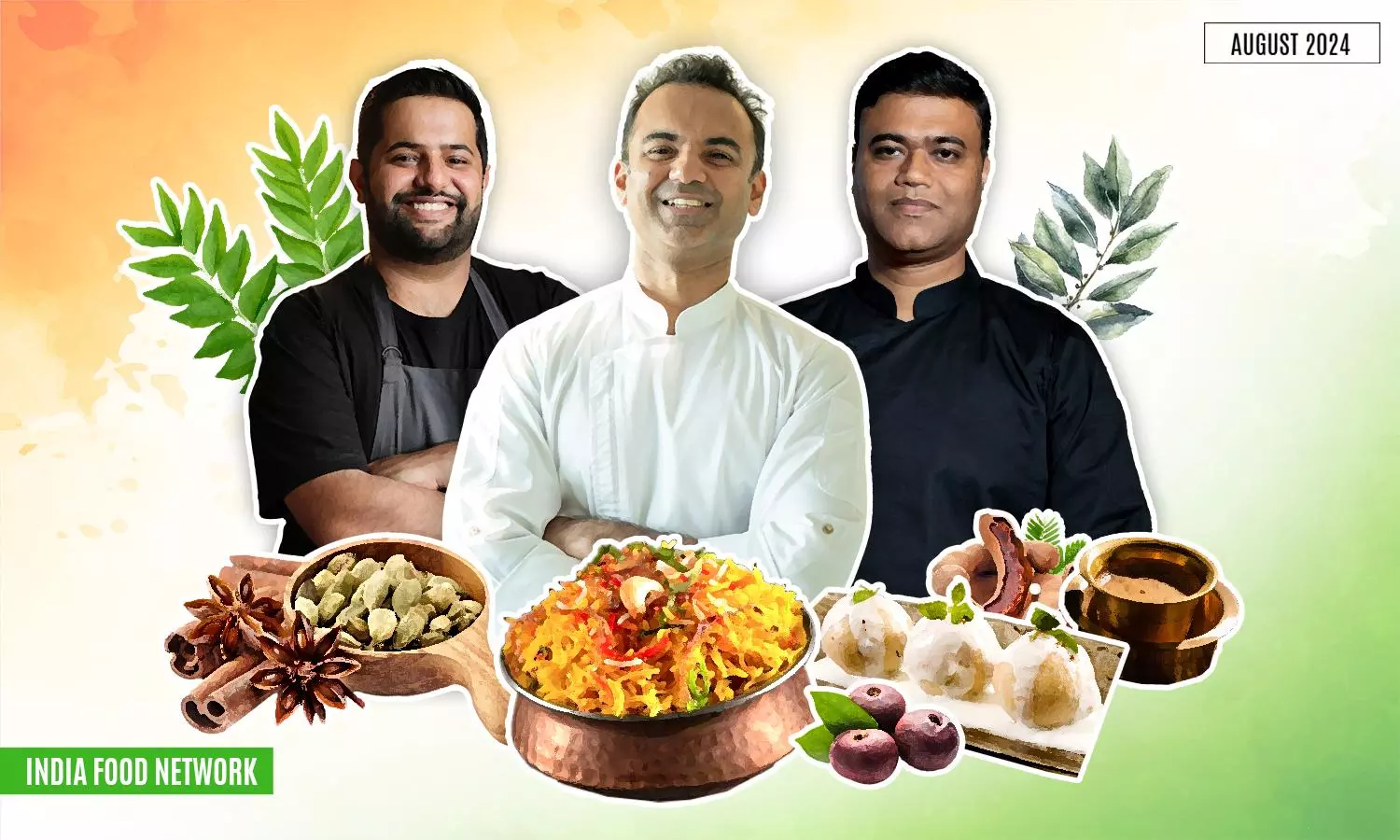Indian cuisine is taking the world by storm and we are here for it!
From Michelin stars to Cannes galas, discover how Indian chefs are redefining global culinary boundaries with flavours that truly captivate
- By Natasha KitturLoading...
- | 5 Aug 2024 11:05 AM IST
 X
X
Indian cuisine is making waves on the global stage, with restaurants and chefs earning prestigious accolades and featuring prominently at renowned events. From Indian restaurants appearing on esteemed lists to Chef Varun Totlani of Masque hosting an Indian Dinner at the Cannes Film Festival, the world is being introduced to a myriad of dishes and flavours. With August marking India's Independence Month, we took the opportunity to chat with three culinary maestros: Chef Varun Totlani of Masque (one of the World's Best 100 Restaurants), Chef Sanket Joshi of Avatara (The Indian outpost of Dubai's all-vegetarian, Michelin Star restaurant), and Chef Sarfaraz Ahmed (Head of Tresind and Carnival by Tresind, India). We delved into their experiences and explored the global obsession with Indian cuisine and their journeys in showcasing it to diverse audiences worldwide.
Edited excerpts from the interview.
Chef Varun Totlani
1. What fun and creative ways do you think we can use to help people around the world discover the delicious regional flavours and unique nuances of Indian cuisine?
That's something we do every day! I love celebrating India through its flavours, cuisine, people, and traditions. We do a lot of collaborations and pop-ups to spread the word, celebrate our food and what we do at the Masque. For instance, we've done some cool collaborations, like a fully plant-based meal when Daniel Humm cooked with us at Eleven Madison Park. It's these kinds of events that help us share the unique flavours we've discovered from travelling around India with both international and national audiences.
Even my experience at the Cannes Festival was fantastic. Not just the diners, but even the chefs in the kitchen were excited to try our flavours. Can you believe that some of them had never tasted tamarind before? I took ingredients like ponk and Indian cacao with me, and it was great to show that cacao grows in India too. We also shared conversations over fresh millets, different spices, and unique cooking techniques. It was a wonderful learning experience for everyone, filled with new flavours and techniques. It's always a fun and exciting time!
2. There’s a growing trend of ‘New Indian Cuisine’ which reinterprets traditional dishes in modern ways. How do you see this trend influencing global perceptions of Indian food?
Oh, absolutely! Indian food is definitely making waves on the international scene right now. There's a real shift in how people see it—it's not just about curry and takeout anymore. Indian restaurants are getting Michelin stars and are becoming some of the hardest reservations to get in cities around the world.
This shift is showing that Indian food can be luxurious and fine dining, not just the commercial Indian food we often think of. People are getting more curious about regional Indian dishes. They don't just want butter chicken anymore; they want to explore the diverse flavors and techniques from different parts of India. We're at an exciting stage right now. Just like French cuisine had its "nouvelle cuisine" era, we're seeing a similar transformation. In a year or two, what we now call modern Indian might just be seen as Indian cuisine, period. It's all about how people interpret and innovate with traditional dishes, and that's what will elevate our cuisine to legendary status.
3. How are modern cooking techniques and technologies influencing the way Indian food is prepared and presented globally?
Technology, especially digital media, has made sharing ideas and finding inspiration so much easier. Back in the day, you'd have to travel to see things for yourself, but now I can just hop on Instagram and see what the world is doing. It’s all about putting your story out there and learning from others. We’re on an even playing field now. We take inspiration from different cuisines to create modern Indian food, and vice versa. It’s no longer about sticking to traditional boundaries. For example, techniques like molecular gastronomy are used globally and adapted to various cuisines, including Indian. It’s all about using globally influenced techniques to achieve the best flavours and results. The end product is what matters, and we’re constantly inspired by and learning from each other to elevate Indian cuisine on the global stage.
4. Have you got any funny or surprising stories from serving Indian food to international guests?
I haven't had any funny or surprising incidents so far. Honestly, it's more about pride than anything funny or surprising. People are pretty familiar with our food these days. When I serve pani puri, for instance, guests often know what it is or have at least heard of it. It's always well-received, and everyone loves the flavours. We don't change our food for different audiences; we stick to the authentic spice levels and flavours. Sometimes, chefs worry it might be too spicy or strong, but we stay true to our roots, and it's always been accepted and loved everywhere we cook. The reactions we get are heartwarming. International guests often have lots of questions and are really into the experience. It's a sense of pride for us to see people enjoy and cherish our food, even if they've never tried Indian food before. So, while there may not be any funny stories, it's always a proud and fulfilling moment to represent my country and cuisine. And that's pretty much it! I'm just happy to represent my country and restaurant and get opportunities like this.
Chef Sanket Joshi
1. What fun and creative ways do you think we can use to help people around the world discover the delicious regional flavours and unique nuances of Indian cuisine?
At Avatara, storytelling is key, both in the presentation of our dishes and in the narratives, we share about the origins and significance of the spices and ingredients we use. Collaborations with guest chefs from various Indian regions can add authenticity and depth to our offerings. Through these creative approaches, we aim to not only showcase the rich diversity of Indian vegetarian cuisine but also to create memorable and enriching experiences for our diners, connecting them deeply with the cultural and culinary heritage of India.
2. Indian cuisine is incredibly diverse, with each region offering unique flavours and dishes. How do you showcase this diversity to international diners?
At Avatara, we highlight the diversity of Indian cuisine by curating menus that showcase the unique flavours and dishes of different regions. By combining traditional recipes with modern culinary techniques, we create a dining experience that both honours and innovates Indian cuisine. Each dish tells a story of its regional origins, allowing international diners to enjoy a flavourful journey through India.
3. What's your secret to getting international foodies hooked on Indian spices and flavours?
For me, it lies in the art of storytelling through food. At Avatara, we don't just serve dishes; we present a culinary journey that captures the essence of India’s diverse regions. Each spice, each ingredient has its own story, a rich cultural background that we weave into our menus. For instance, when we introduce Naivedhya (an offering made to god or nature) to the guest, I share its historical significance and health benefits, explaining how it's been a staple in Indian culture for centuries. By doing so, I create a deeper connection between the diner and the food, transforming a simple meal into a memorable experience.
4. Have you got any funny or surprising stories from serving Indian food to international guests?
At Avatara, it’s often with our 9th course Krishna Phal, where not just the international guests, but the Indian crowd also finds it surprising, when we inform them to eat it in one go to truly experience the burst of flavours. We often see their expression filled with surprise and laughter when they experience or feel the hit of the chilled spiced water with a crunch due to the shell. It’s just like having a pani puri, but with a modern twist.
Chef Sarfaraz Ahmed
1. What fun and creative ways do you think we can use to help people around the world discover the delicious regional flavours and unique nuances of Indian cuisine?
To establish a strong presence on the global culinary scene, it is crucial to highlight Indian ingredients and dishes. We aim to entice travellers to experience these delicacies at regional and sub-regional levels. More restaurants with a philosophy of promoting regional flavours are needed to represent themselves on prestigious platforms like Asia’s 50 Best, World’s 50 Best, and other global stages. At Passion F&B, we continuously strive to align ourselves with market trends and the global culinary scene, creating unforgettable experiences through our cuisine.
2. With some traditional or regional Indian ingredients being hard to source, how do you adapt your recipes without compromising on authenticity?
Given that our cuisine and language vary every few kilometres, each region and subregion has its own specialties. At Tresind, we incorporate dishes inspired by all regions of India, offering a culinary journey that spans North, West, East, and South India, capturing the essence of their distinct flavours. We embrace the challenge of sourcing traditional or regional Indian ingredients by focusing on innovation without losing authenticity. When specific ingredients are hard to come by, we turn to locally available substitutes that can replicate the desired flavours and textures. This approach ensures the integrity of our dishes while allowing us to blend traditional techniques with modern culinary practices.
3. How do you balance maintaining the authenticity of Indian recipes with the need to adapt them to suit international palates?
India's culinary landscape is incredibly diverse, rich in unique ingredients, spices, and flavours. Some spices and ingredients are native to India and have made their way to international forums. We identify and promote these by educating diners about their origins, quality, and benefits through our dishes and storytelling.
4. Have you got any funny or surprising stories from serving Indian food to international guests?
Absolutely! One time, we served chaat, which is a quintessential part of Indian street food. It’s a complex dish with diverse flavours, and we took the time to explain its story, its layers, and even the literal meaning of "chaat," which is "to lick." Despite our efforts, one of our guests still perceived it as a spicy salad! It was amusing but also highlighted how different and unique Indian cuisine can be to those unfamiliar with it.

Natasha Kittur
Natasha Kittur is an aspiring writer. Her love for anything with cheese and spice is profound, but a white sauce pasta always tops her list. In her free time you will catch her reading or watching crime books and shows or go on and on about psychological experiments and theories. She aims to write a book in the fictional genre someday.


